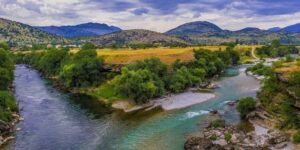Physical Address
23,24,25 & 26, 2nd Floor, Software Technology Park India, Opp: Garware Stadium,MIDC, Chikalthana, Aurangabad, Maharashtra – 431001 India
Physical Address
23,24,25 & 26, 2nd Floor, Software Technology Park India, Opp: Garware Stadium,MIDC, Chikalthana, Aurangabad, Maharashtra – 431001 India

By Aayushi Sharma
A study published in Nature Communications last month suggests that a massive proposal to join several of India’s rivers and shift massive volumes of water for irrigation could lead to decreased rainfall in already water-stressed regions. According to the study, the water transfer may have an impact on the climatic systems that drive the Indian monsoon and decrease September rainfall by up to 12% in some of the nation’s states.
This report is part of an ongoing series of independent investigations on the contentious proposal. A few scientists have advised against implementing the river engineering project since there is not enough information regarding how it will affect the environment.
What is river interlinking?
A significant effort to increase storage capacity and move water from locations with surplus water to more drought-prone areas through inter-basin transfers is the connecting of rivers. The goal of connecting India’s principal rivers is to lessen the country’s severe spatial disparity in the availability of water resources. When it comes to resources like water, which cut over state lines and serve as lifelines for entire communities, an integrated approach is required. Water supply imbalances in river deltas and drainage basins may require the transfer of water from excess to deficit locations. The rationale for connecting the rivers is that while many regions of the nation experience annual flooding, many others struggle with drought.
Scenario of River Linking in India
With a population of 1.4 billion, agriculture is a major economic sector of India, where large international rivers like the Ganga, Brahmaputra, and Indus are essential to the country’s prosperity. However, pollution, unchecked human water usage, climate change, and rapid population development have put Indian river basins—like river basins worldwide—under extreme stress. The main source of water for Indian river basins, which supplies almost 80% of the nation’s yearly rainfall and sets the GDP, is the Indian summer monsoon, which runs from June to September. The intensity, frequency, and spatial variability of extreme rainfall have increased in ISM over the past several decades, whereas the mean rainfall has decreased. In India, hydrologic extremes such as floods and droughts have intensified due to these shifting climatic patterns.
Is the river linking plan leading to adverse climate impacts?
To move 174 billion cubic meters of water annually—roughly equal to Pakistan’s annual water use—from areas with an abundance of water to those in need, the Indian Water Ministry intends to build a network of 15,000 kilometers of canals and thousands of reservoirs. The project aims to “keep the maximum possible water— which previously used to reach oceans from river basins— on the land to meet the growing water demand of the country,” according to the study’s authors. While other studies have evaluated the project’s possible effects, such as sediment deposition and the effects on aquatic ecosystems, this is the first to evaluate how the interaction of the atmosphere and the land affects the water cycles between them.
According to one of the study’s authors, Subimal Ghosh, a climate scientist at the Indian Institute of Technology (IIT) Bombay in Mumbai, the water cycle is influenced by climatic patterns, plants that release moisture into the atmosphere, oceans, and plants. “How a river basin in one region impacts atmospheric processes and therefore impacts other regions as well,” he explains, is the goal his team set out to investigate.
Increasing the area under irrigation by 35 million hectares is one of the main goals of the river-linking plan. Higher amounts of evapotranspiration—the release of moisture from leaves—would result in more crops. Local temperatures would drop, rainfall patterns would alter, and clouds would form in response to increased moisture in the atmosphere.
According to the study, September is when the land-atmosphere interaction has the biggest impact. One of the authors highlights that “September is when evapotranspiration is high and crops are at maturity.” As a result, the states of Rajasthan, Gujarat, Odisha, and Andhra Pradesh saw a 6.4%–12% decrease in September rainfall. Additionally, the northeastern states of Bihar and Jharkhand as well as central Maharashtra and adjoining Telangana had increases in September precipitation of up to 12% and 10%, respectively.
According to the authors, less rainfall will result in reduced river flow in the months to follow, which might worsen water stress in already parched areas like Rajasthan and Gujarat. A meteorologist at the Indian Institute of Tropical Meteorology in Pune’s International Monsoons Project Office, Rupa Kumar Kolli, calls the paper “a significant contribution.” For the river-linking project to proceed, he expects that the report will force a more in-depth investigation. Once the project is put into action, there is no turning back.
If you have any queries or come across suspicious content related to climate change or the environment and want us to verify them, send them to Climate Buddy, our WhatsApp tipline +91 70453 66366.
Reference:
https://www.nature.com/articles/d41586-023-03193-1
https://www.nature.com/articles/s41467-023-41668-x
https://www.science.org/doi/abs/10.1126/science.1132027
https://www.nature.com/articles/s41467-021-25026-3
Image Source:
https://www.thecitizen.in/index.php/en/NewsDetail/index/13/21452/The-History-of-Interlinking-Rivers-